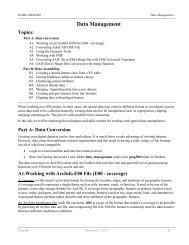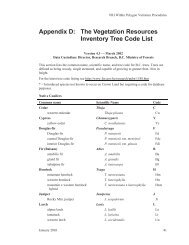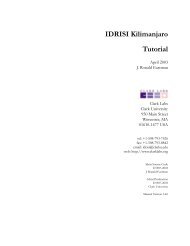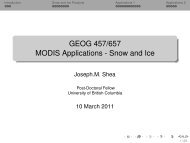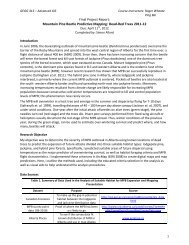Understanding Map Projections
Understanding Map Projections
Understanding Map Projections
You also want an ePaper? Increase the reach of your titles
YUMPU automatically turns print PDFs into web optimized ePapers that Google loves.
WINKEL I<br />
Distance<br />
Generally, scale is made true along latitudes 50°28' N<br />
and S.<br />
LIMITATIONS<br />
Neither conformal nor equal area. Useful only for<br />
world maps.<br />
The central meridian is 0°.<br />
USES AND APPLICATIONS<br />
Developed for use in general world maps. If the<br />
standard parallels are 50°28' N and S, the total area<br />
scale is correct, but local area scales vary.<br />
DESCRIPTION<br />
Often used for world maps, the Winkel I projection<br />
is a pseudocylindrical projection that averages the<br />
coordinates from the Equirectangular (Equidistant<br />
Cylindrical) and Sinusoidal projections. Developed<br />
by Oswald Winkel in 1914.<br />
PROJECTION METHOD<br />
Pseudocylindrical. Coordinates are the average of the<br />
Sinusoidal and Equirectangular projections.<br />
Meridians are equally spaced sinusoidal curves<br />
curving toward the central meridian. The central<br />
meridian is a straight line. Parallels are equally<br />
spaced straight lines. The length of the poles and the<br />
central meridian depends on the standard parallels.<br />
If the standard parallel is the equator, Eckert V<br />
results.<br />
LINEAR GRATICULES<br />
The parallels and the central meridian.<br />
PROPERTIES<br />
Shape<br />
Generally distorted.<br />
Area<br />
Generally distorted.<br />
Direction<br />
Generally distorted.<br />
96 • <strong>Understanding</strong> <strong>Map</strong> <strong>Projections</strong>




